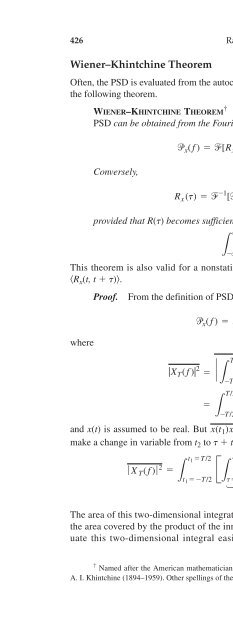563489578934
426 Random Processes and Spectral Analysis Chap. 6 Wiener–Khintchine Theorem Often, the PSD is evaluated from the autocorrelation function for the random process by using the following theorem. When x(t) is a wide-sense stationary process, the PSD can be obtained from the Fourier transform of the autocorrelation function: WIENER–KHINTCHINE THEOREM † Conversely, provided that R(t) becomes sufficiently small for large values of t, so that (6–44) (6–45) ƒ tR(t) ƒ dt 6q (6–46) L-q This theorem is also valid for a nonstationary process, provided that we replace R x (t) by R x (t, t + t). where Proof. q x(f) = [R x (t)] = R x (t)e -j2pft dt L q R x (t) = -1 [ x (f)] = x (f)e j2pft df L From the definition of PSD, x (f) = lim T : q a ƒ X 2 T(f) ƒ b T |X T (f)| 2 = ` L q T/2 -T/2 = L T/2 T/2 -T/2 L-T/2 -q -q x(t)e -jvt dt ` 2 x(t 1 )x(t 2 )e -jvt 1 e jvt 2 dt 1 dt 2 and x(t) is assumed to be real. But x(t 1 )x(t 2 ) = R x (t 1 , t 2 ). Furthermore, let t = t 2 - t 1 , and make a change in variable from t 2 to t t 1 . Then t 1 = T/2 t = T/2- t 1 ƒ X T (f) ƒ 2 = B R x (t 1, t 1 + t)e -jvt dtR dt 1 (6–47) L t 1 = -T/2 L t =-T/2- t 1 1 The area of this two-dimensional integration is shown in Fig. 6–4. In the figure, 1 denotes the area covered by the product of the inner integral and the differential width dt 1 . To evaluate this two-dimensional integral easily, the order of integration will be exchanged. ⎧ ⎪⎪⎪⎪⎪⎪⎪⎪⎪⎨⎪⎪⎪⎪⎪⎪⎪⎪⎪⎩ † Named after the American mathematician Norbert Wiener (1894–1964) and the German mathematician A. I. Khintchine (1894–1959). Other spellings of the German name are Khinchine and Khinchin.
- Page 850: PROBLEMS Problems 401 ★ 5-1 An AM
- Page 854: Problems 403 v 3 (t) Low-pass filte
- Page 858: Problems 405 5-25 A transmitter pro
- Page 862: Problems 407 5-41 A frequency modul
- Page 866: Problems 409 FM receiver FM detecto
- Page 870: Problems 411 (d) Sketch the wavefor
- Page 874: Problems 413 (a) Show that the Gaus
- Page 878: Sec. 6-1 Some Basic Definitions 415
- Page 882: Sec. 6-1 Some Basic Definitions 417
- Page 886: Sec. 6-1 Some Basic Definitions 419
- Page 890: Sec. 6-1 Some Basic Definitions 421
- Page 894: Sec. 6-1 Some Basic Definitions 423
- Page 898: Sec. 6-2 Power Spectral Density 425
- Page 904: 428 Random Processes and Spectral A
- Page 908: 430 Random Processes and Spectral A
- Page 912: 432 Random Processes and Spectral A
- Page 916: 434 Random Processes and Spectral A
- Page 920: 436 Random Processes and Spectral A
- Page 924: 438 Random Processes and Spectral A
- Page 928: 440 Random Processes and Spectral A
- Page 932: 442 Random Processes and Spectral A
- Page 936: 444 Random Processes and Spectral A
- Page 940: 446 Random Processes and Spectral A
- Page 944: 448 Random Processes and Spectral A
- Page 948: 450 Random Processes and Spectral A
426<br />
Random Processes and Spectral Analysis Chap. 6<br />
Wiener–Khintchine Theorem<br />
Often, the PSD is evaluated from the autocorrelation function for the random process by using<br />
the following theorem.<br />
When x(t) is a wide-sense stationary process, the<br />
PSD can be obtained from the Fourier transform of the autocorrelation function:<br />
WIENER–KHINTCHINE THEOREM †<br />
Conversely,<br />
provided that R(t) becomes sufficiently small for large values of t, so that<br />
(6–44)<br />
(6–45)<br />
ƒ tR(t) ƒ dt 6q<br />
(6–46)<br />
L-q<br />
This theorem is also valid for a nonstationary process, provided that we replace R x (t) by<br />
R x (t, t + t).<br />
where<br />
Proof.<br />
q<br />
x(f) = [R x (t)] = R x (t)e -j2pft dt<br />
L<br />
q<br />
R x (t) = -1 [ x (f)] = x (f)e j2pft df<br />
L<br />
From the definition of PSD,<br />
x (f) = lim<br />
T : q a ƒ X 2<br />
T(f) ƒ<br />
b<br />
T<br />
|X T (f)| 2 = `<br />
L<br />
q<br />
T/2<br />
-T/2<br />
=<br />
L<br />
T/2<br />
T/2<br />
-T/2 L-T/2<br />
-q<br />
-q<br />
x(t)e -jvt dt `<br />
2<br />
x(t 1 )x(t 2 )e -jvt 1<br />
e jvt 2<br />
dt 1 dt 2<br />
and x(t) is assumed to be real. But x(t 1 )x(t 2 ) = R x (t 1 , t 2 ). Furthermore, let t = t 2 - t 1 , and<br />
make a change in variable from t 2 to t t 1 . Then<br />
t 1 = T/2 t = T/2- t 1<br />
ƒ X T (f) ƒ 2 = B R x (t 1, t 1 + t)e -jvt dtR dt 1 (6–47)<br />
L t 1 = -T/2 L t =-T/2- t 1<br />
1<br />
The area of this two-dimensional integration is shown in Fig. 6–4. In the figure, 1 denotes<br />
the area covered by the product of the inner integral and the differential width dt 1 . To evaluate<br />
this two-dimensional integral easily, the order of integration will be exchanged.<br />
⎧ ⎪⎪⎪⎪⎪⎪⎪⎪⎪⎨⎪⎪⎪⎪⎪⎪⎪⎪⎪⎩<br />
† Named after the American mathematician Norbert Wiener (1894–1964) and the German mathematician<br />
A. I. Khintchine (1894–1959). Other spellings of the German name are Khinchine and Khinchin.



